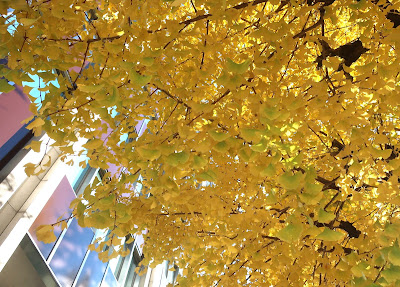The ginkgo (Ginkgo biloba), a gymnosperm plant, has male and female trees. The male does not produce flowers but pollen while the female produces fruits from September to November. In Central Tokyo, you can see many ginkgo trees but most of them in the office district are male to prevent people from stepping on the fruits. Ginkgo fruits are so stinky, smelling like something rotten, when raw that nobody wouldn't want to step on them but they're considered one of the autumn delicacies in Japan.
Its leaves turn bright yellow (or golden!) beautifully. According to "The Process of Leaf Color Change," in autumn triggered by shorter days and lower temperatures the leaves stop their food making process. The chlorophyll breaks down, the green colour disappears and the yellow and orange colours become visible. At the same time other chemical changes may occur which form additional colours through the development of red pigments. Some mixtures give rise to reddish and purplish autumn colours such as dogwoods and sumachs, while others give maple its brilliant orange. The autumn foliage of some trees show only yellow colours, whilst others like oaks show only brown. All these colours are the varying amounts of the chlorophyll residue and other pigments in the leaf.
The next question is how? Does the color change happen in all parts of the leaves at the same time or from one part to another? You can see the answer in the last two photos of ginkgo leaves changing yellow from the edge to the middle😊!





